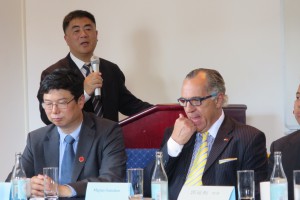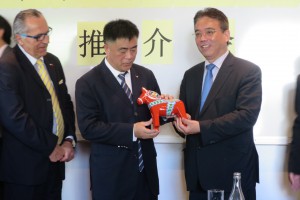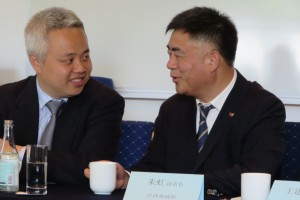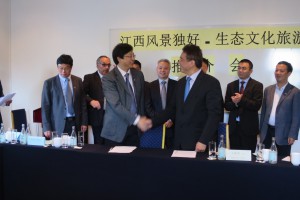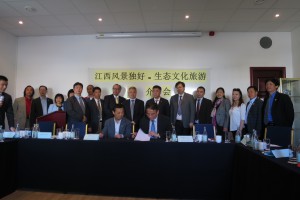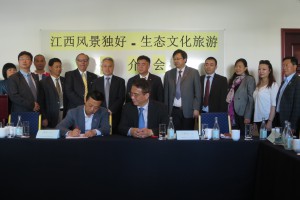China Focus: Key China-U.S. dialogue set for next week
BEIJING, June 19 (Greenpost) — High-ranking officials from China and the United States will meet next week in Washington D.C. to discuss issues ranging from security to the economy and people-to-people exchanges, the Chinese Foreign Ministry said on Friday.
The two countries have decided that the seventh China-U.S. Strategic and Economic Dialogue (S&ED) and the sixth China-U.S. High-Level Consultation on People-to-People Exchange (CPE) will take place on June 23 and 24, Foreign Ministry spokesperson Lu Kang said.
The S&ED will be co-chaired by Vice Premier Wang Yang and State Councilor Yang Jiechi, who will act as special representatives of Chinese President Xi Jinping, and U.S. Secretary of State John Kerry and Treasury Secretary Jacob Lew, who will act for U.S. President Barack Obama.
The CPE will be co-chaired by Vice Premier Liu Yandong and Kerry.
“China is ready to work with the United States to implement the consensus reached by their leaders, enhance strategic communication, promote mutually beneficial cooperation, properly handle differences, so as to push for new progress in the building of a new model of major power relationship,” said Lu.
The CPE will discuss cooperation in education, science and technology, culture, health, sports, women and youth, according to the spokesperson.
The S&ED and CPE, among more than 90 dialogue mechanisms between China and the United States, have become the most important regular platforms between the two countries, gathering dozens of influential officials in fields ranging from trade and finance to diplomacy and defense.
“The coming S&ED and CPE will help enhance mutual understanding and build trust, promote cooperation and make preparations for President Xi Jinping’s visit to the United States in September,” Assistant Foreign Minister Zheng Zeguang said on Friday.
Xi accepted U.S. President Barack Obama’s invitation for a state visit during a phone conversation in February.
It will be Xi’s first state visit to the United States since he became president in 2013.
“This year’s strategic dialogue will cover a wide range of topics,including bilateral, regional and global issues of common concern,” Zheng said.
Hot topics include climate change, China-U.S. interaction in the Asia-Pacific region, management of differences and sensitive issues, United Nations and multilateral issues, science and innovation, green ports and ships and the illegal trade in animals and plants.
Ahead of the strategic dialogue, Chinese and U.S. representatives of the military and related departments will meet to discuss security, Zheng said.
“The major task for the economic dialogue is to reach agreement on economic issues and create a good environment for the presidential summit in September,” China’s vice finance minister Zhu Guangyao said.
At the economic dialogue, officials will have in-depth discussions on macro-economic policy and restructuring, promoting trade and investment and stabilizing and reforming the financial market, according to Zhu.
As the world’s two largest economies, the United States and China are increasingly economically interdependent, with their trade volume hitting 550 billion U.S. dollars last year.
U.S. investment in China has amounted to nearly 100 billion U.S. dollars, while Chinese investment in the United States has also grown, official data indicates.
“Increasing China-U.S. economic cooperation is not only in tune with the requirements of the two peoples, but also a reflection of two countries’ efforts to shoulder their responsibilities as world powers,” Zhu said.
The fact that the CPE and S&ED are being jointly held in the United States for the first time this year shows the seriousness in which the two sides are aiming to build their new-model relationship, according to Chinese Vice Minister of Education Liu Limin.
He said people-to-people exchanges are irreplaceable and he is looking forward to the upcoming consultation.
A range of China-U.S. events will take place in America during the Chinese leaders’ time there.
Liu Yandong will address a forum for university presidents of the two countries. Twenty-six Chinese university chiefs and 23 from the United States are scheduled to attend.
As this year marks the 70th anniversary of victory in the World Anti-Fascist War and also victory in the Chinese People’s War of Resistance Against Japanese Aggression, the Chinese People’s Association for Friendship with Foreign Countries and the Chinese Embassy to the United States will hold a joint exhibition to commemorate cooperation between China and the United States in World War II, Liu Limin said.
Liu Yandong will deliver a speech at a dialogue with female leaders from the two countries.
She will attend a seminar aiming to help African countries improve their healthcare systems and the opening ceremony of a competition for young technology enthusiasts.
According to Liu Limin, one of the achievements of the CPE is expected to be a plan for China to invite 100 American youth leaders to visit China for a study tour in the coming five years.
The coming activity will follow a U.S. visit by Fan Changlong, vice chairman of China’s Central Military Commission, earlier this month. Fan said during the trip that the the two nations “should take the higher ground to look into the future and gain perspective on regional and international issues”.
His U.S. meetings saw discussion of a “mutual trust mechanism” covering encounters in the air, building on such mechanisms for land-based and maritime encounters, Zheng said.
The main goal of Fan’s visit was to create “a positive atmosphere” for Xi’s September U.S. visit, according to Guan Youfei, director of the Foreign Affairs Office of the National Defense Ministry. Enditem
Source Xinhua
Editor Xuefei Chen Axelsson
